| | Published October 9th, 2013
| Let's Eat!
Lamorinda gardeners get the most from their gardens
| | By Chris Lavin | 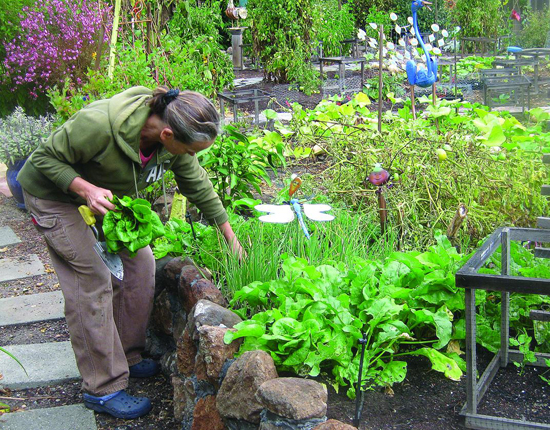 | | Ellen Bier grows dozens of edibles in her Sleepy Hollow neighborhood in Orinda. Photo Chris Lavin
|
Walk through any gate into an edible garden here, but don't tap the gardener on the shoulder unless you're prepared for a quick tour and a baffling list of names and varieties. That's not a bean, but a roma, and that's not a tomato but an "Esther's Mortgage Lifter." Not a pumpkin but a kabocha.
 You get the picture.
You get the picture.
 Throughout Lamorinda edible gardens produce way more, at times, than the family can handle, which turns out to be a boon for the neighbors, even the postman. More than churn out food for the family, the gardens connect their owners to the land, immersing them in the outdoors, revealing microclimates, and attracting so many birds some gardens look like aviaries.
Throughout Lamorinda edible gardens produce way more, at times, than the family can handle, which turns out to be a boon for the neighbors, even the postman. More than churn out food for the family, the gardens connect their owners to the land, immersing them in the outdoors, revealing microclimates, and attracting so many birds some gardens look like aviaries.
 "The towhees are going absolutely crazy right now," said Ellen Bier, an Orinda gardener who tore out the backyard pool a few years ago to get more garden space. A nut-brown towhee almost flew between her legs, where she stood next to a zucchini. "We still call this area 'the deep end.'"
"The towhees are going absolutely crazy right now," said Ellen Bier, an Orinda gardener who tore out the backyard pool a few years ago to get more garden space. A nut-brown towhee almost flew between her legs, where she stood next to a zucchini. "We still call this area 'the deep end.'"
 According to the National Gardening Association, 13 percent of the U.S. population picks up a trowel to plant something each year. But a brief survey of nurseries puts the local figure at closer to half.
According to the National Gardening Association, 13 percent of the U.S. population picks up a trowel to plant something each year. But a brief survey of nurseries puts the local figure at closer to half.
 "A lot of people garden here," said Kenny Murakami, who runs Moraga Garden Center. "It's a broad spectrum. There are people with huge gardens, and people with backyard gardens that are very productive. And there a lot of people who are extremely knowledgeable."
"A lot of people garden here," said Kenny Murakami, who runs Moraga Garden Center. "It's a broad spectrum. There are people with huge gardens, and people with backyard gardens that are very productive. And there a lot of people who are extremely knowledgeable."
 Murakami's customers speak of him like a rock star, a fountain of information. While he has reached hero status among his clientele, "I'm just a guy who likes plants," he said. And he's not the only one who likes to give tips. Most gardeners can't contain themselves, and will spout a tip about gardening (or eating) every third step or so.
Murakami's customers speak of him like a rock star, a fountain of information. While he has reached hero status among his clientele, "I'm just a guy who likes plants," he said. And he's not the only one who likes to give tips. Most gardeners can't contain themselves, and will spout a tip about gardening (or eating) every third step or so.
 TIP: To de-stem a strawberry, insert a stiff straw into the top a half inch, and twist. Stem can then be shot through said straw at a neighboring gardener. (Bobbie Preston, Moraga)
TIP: To de-stem a strawberry, insert a stiff straw into the top a half inch, and twist. Stem can then be shot through said straw at a neighboring gardener. (Bobbie Preston, Moraga)
 While Murakami's advice might help, gardeners themselves must get to know their yards and space the hard way, by living with it through the years to become familiar with their particular microclimates. The front yard, even, can be different than the back.
While Murakami's advice might help, gardeners themselves must get to know their yards and space the hard way, by living with it through the years to become familiar with their particular microclimates. The front yard, even, can be different than the back.
 "We put our garden in the front yard, at first, because that's where the sun was," said Bobbie Preston, who moved to her lower Larch home in Moraga in 1984. "Now we keep it there. I can give a child who's walking by with his mother a little pumpkin, or a warm tomato fresh off the vine."
"We put our garden in the front yard, at first, because that's where the sun was," said Bobbie Preston, who moved to her lower Larch home in Moraga in 1984. "Now we keep it there. I can give a child who's walking by with his mother a little pumpkin, or a warm tomato fresh off the vine."
 That's not to say she doesn't keep, oh, a few things around back. Even though the Prestons live on a typical quarter-acre lot, they have constructed beds down to Moraga Creek and planted 18 dwarf fruit trees and more than 50 varieties of edible plants. Not to mention the bird houses, nesting boxes, bat house, and a menagerie of animal sculptures.
That's not to say she doesn't keep, oh, a few things around back. Even though the Prestons live on a typical quarter-acre lot, they have constructed beds down to Moraga Creek and planted 18 dwarf fruit trees and more than 50 varieties of edible plants. Not to mention the bird houses, nesting boxes, bat house, and a menagerie of animal sculptures.
 TIP: There is sex outside marriage. Squash plants have both male and female flowers. To ensure fertilization, use a Q-Tip. (Ellen Bier, Orinda)
TIP: There is sex outside marriage. Squash plants have both male and female flowers. To ensure fertilization, use a Q-Tip. (Ellen Bier, Orinda)
 Yet even with multiple seasons under her belt, Preston is still finding out what grows best where.
Yet even with multiple seasons under her belt, Preston is still finding out what grows best where.
 "I move plants around like they were furniture," she said, pointing to a 5-year-old apple tree she moved last year. "I'm a big believer that you can move anything in October, when it stops growing for the season."
"I move plants around like they were furniture," she said, pointing to a 5-year-old apple tree she moved last year. "I'm a big believer that you can move anything in October, when it stops growing for the season."
 Susan Andersen-Berger of Orinda has at least three microclimates in her yard, she said, standing on a large circle of pristine lawn grass bedecked with chairs overlooking Mount Diablo. "This used to be the garden, for instance," she said - but the wind whipped the plants mercilessly in the fall and it got too cold. Now her ornamentals are on one side, and her edibles are protected by a hill down-slope from the lawn. She strolled through from one side to the other, naming each of dozens of plants.
Susan Andersen-Berger of Orinda has at least three microclimates in her yard, she said, standing on a large circle of pristine lawn grass bedecked with chairs overlooking Mount Diablo. "This used to be the garden, for instance," she said - but the wind whipped the plants mercilessly in the fall and it got too cold. Now her ornamentals are on one side, and her edibles are protected by a hill down-slope from the lawn. She strolled through from one side to the other, naming each of dozens of plants.
 "As I got more and more into it, I had to make more spaces," Andersen-Berger said.
"As I got more and more into it, I had to make more spaces," Andersen-Berger said.
 "This is my sanity," she said, touching the plants as she went. "Honestly, I love it out here. I spent as much time in the garden as I can."
"This is my sanity," she said, touching the plants as she went. "Honestly, I love it out here. I spent as much time in the garden as I can."
 TIP: While a pumpkin in your patch is growing, carve a child's name into the flesh. By Halloween, the name will have grown scarred and scary. (Preston)
TIP: While a pumpkin in your patch is growing, carve a child's name into the flesh. By Halloween, the name will have grown scarred and scary. (Preston)
 Andersen-Berger's thoughts are a common theme among gardeners, who balance the stress of life with the turning of the soil to plant new things. And the harvest is only part of the cycle. It is difficult to find a gardener who doesn't like to cook. They seem to talk about cooking just as much as varieties of tomato.
Andersen-Berger's thoughts are a common theme among gardeners, who balance the stress of life with the turning of the soil to plant new things. And the harvest is only part of the cycle. It is difficult to find a gardener who doesn't like to cook. They seem to talk about cooking just as much as varieties of tomato.
 "Isn't this beautiful?" asked Preston, who had just put a batch of figs through the Cuisinart - her neighbor, she said, luckily doesn't enjoy figs. Preston also had a plate of cut figs drizzled with balsamic vinegar and gorgonzola on her granite kitchen counter. "Taste it!"
"Isn't this beautiful?" asked Preston, who had just put a batch of figs through the Cuisinart - her neighbor, she said, luckily doesn't enjoy figs. Preston also had a plate of cut figs drizzled with balsamic vinegar and gorgonzola on her granite kitchen counter. "Taste it!"
 Using her neighbor's figs is a good example of the small communities within the community who share their abundance.
Using her neighbor's figs is a good example of the small communities within the community who share their abundance.
 "We don't plant the same things anymore," Preston said of her neighbors, meaning that "Candy has melons and beans - so, so many beans - and Antoinette always has more eggplants than she knows what to do with." So they plan ahead and end up swapping amongst themselves. "I'm never going to buy parsley again," Preston said.
"We don't plant the same things anymore," Preston said of her neighbors, meaning that "Candy has melons and beans - so, so many beans - and Antoinette always has more eggplants than she knows what to do with." So they plan ahead and end up swapping amongst themselves. "I'm never going to buy parsley again," Preston said.

|
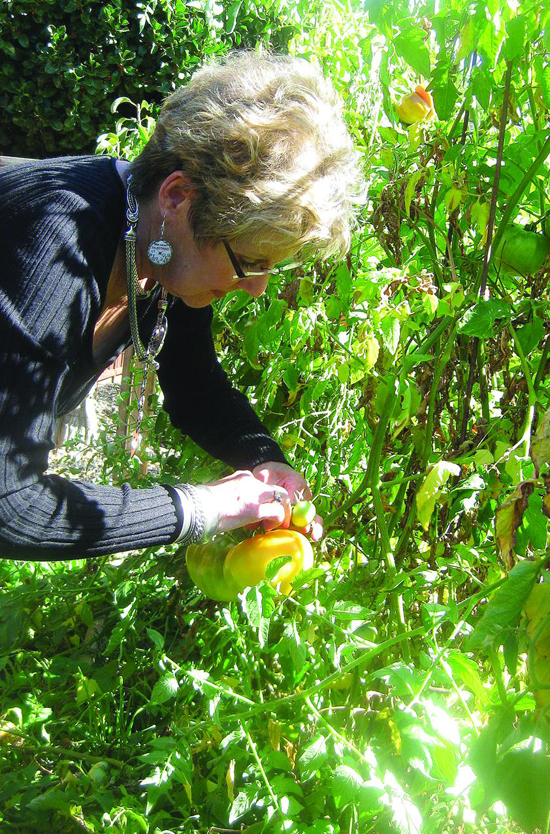 | | Preston picks a Golden Wonder in her front yard in Moraga.
| 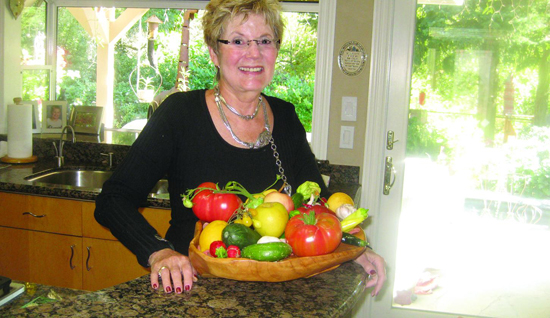 | | Bobbie Preston with a daily harvest.
| 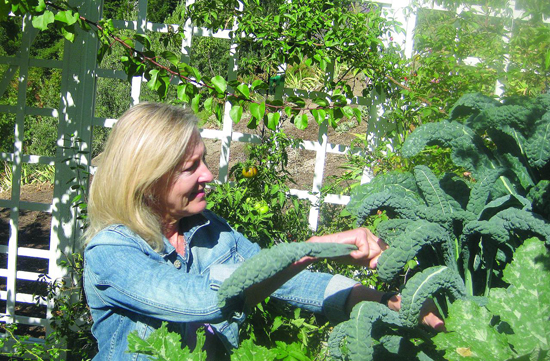 | | Susan Anderson-Berger harvests dinosaur kale in her Orinda garden. Photos Chris Lavin
| 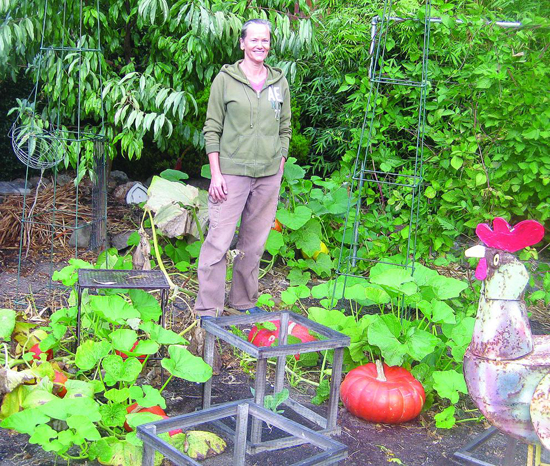 | | Ellen Bier will decorate her house with her own pumpkins this Halloween. Photos Chris Lavin
| | | | | | | |
| | | print story
Before you print this article, please remember that it will remain in our archive for you to visit anytime.
download pdf
(use the pdf document for best printing results!) | | | Comments | | |
| | | | | | | | | | | | | | | | |






